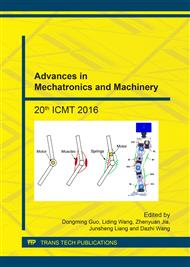[1]
Krishnakumar Kulankara, Srinath Satyanarayana, Shreyes N. Melkote, Iterative fixture layout and clamping force optimization using the genetic algorithm, Journal of Manufacturing Science and Engineering, 124 (2002) 119-125.
DOI: 10.1115/1.1414127
Google Scholar
[2]
Gonzalol, Peigné G, Gonzalez D, High speed machining simulation of thin-walled components, 5th International Conference On High Speed Machining, Metz (France) (2006).
Google Scholar
[3]
Ratchev S, Govender E, Nikov S et al, Force and deflection modelling in milling of low-rigidity complex parts, Journal of Materials Processing Technology, 143 (2003) 796-801.
DOI: 10.1016/s0924-0136(03)00382-0
Google Scholar
[4]
Ratchev S, Liu S, Huang W et al, An advanced FEA based force induced error compensation strategy in milling, International Journal of Machine Tools and Manufacture, 46 (2006) 542-551.
DOI: 10.1016/j.ijmachtools.2005.06.003
Google Scholar
[5]
Jitender K. Rai, Paul Xirouchakis, Finite element method based machining simulation environment for analyzing parts errors induced during milling of thin-walled components, International Journal of Machine Tools and Manufacture, 48 (2008) 629-643.
DOI: 10.1016/j.ijmachtools.2007.11.004
Google Scholar
[6]
Lionel Arnaud, Oscar Gonzalo, Sébastien Seguy et al, Simulation of low rigidity parts machining applied to thin-walled structures, International Journal of Advanced Manufacturing Technology, 54 (2011) 479-488.
DOI: 10.1007/s00170-010-2976-9
Google Scholar
[7]
Wang Z J, Chen W Y, Zhang Y D et al, Study on the Machining Distortion of Thin-walled Part Caused by Redistribution of Residual Stress, Chinese Journal of Aeronautics, 18 (2005) 175-179.
DOI: 10.1016/s1000-9361(11)60325-7
Google Scholar
[8]
He N, Yang Y F, Li L et al, Machining Deformation of Aircraft Structure and Its Control, Aeronautical Manufacturing Technology, 6 (2009) 33-35.
Google Scholar
[9]
Song G, Li J F, Sun J et al, Analysis on prediction of surface error based on precision milling cutting force model, Journal of Mechanical Engineering, 49 (2013) 169-175.
DOI: 10.3901/jme.2013.21.168
Google Scholar
[10]
Wu H B, Ke Y L, Liu G et al, Study on milling deformation of aerospace frame monolithic components, Journal of Zhejiang University, 43 (2009).
Google Scholar
[11]
Zhao W, He N, Li L et al, High efficiency milling of thin-walled components, Aviation Precision Manufacturing Technology, 38 (2002) 12-15.
Google Scholar
[12]
Ni L J, Research on design optimization technology in computer aided fixture design, Nanjing: Nanjing University of Aeronautics and Astronautics, (2007).
Google Scholar
[13]
Wang X P, Cao L M, Genetic algorithm: Theory, Application and Software implementation, Xi'an Jiao Tong University Press, (2002).
Google Scholar


